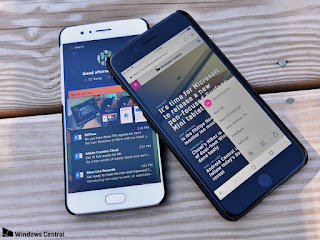An Android app development company India provides services to build
applications for one of the most popular platforms these days, the
Android operating system. At present, Microsoft takes on the struggling
Edge Browser to Android and iOS operating systems. Edge uses the same
WebKit engine, which powers the Safari of Apple. The Android Edge in the
meantime is based on the Blink engine that Google maintains for Chrome.
With Microsoft Edge available on the two operating systems, the user
base will triple. Not only that, Microsoft also makes it easier for
users to synchronize passwords, tabs and other information to be more
available. This will be very productive and empowers people to do and of
course achieve more.
EDGE FOR MOBILE APPS TESTING
Microsoft has announced that it had created Android and iOS versions of its struggling Edge browser and will make both available to users for testing. This is great news for any mobile app design company, whether in India or in other places where mobile application development is one of the major source of income. Microsoft cast the Edge variations as vital in fleshing out the Windows 10 feature known as ‘Continue on PC’, that would debut with the Fall Creators Update, aka 1709 upgrade that begun shipping in October 17.
The feature links a particular phone or tablet, to a Windows 10 personal computer. It then automatically hands off certain in-progress tasks, like a half-finished Office document that’s opened in a browser, from device to device. What the Edge on Android or iOS truly stand out is its ability of continuing on a personal computer. It enables a developer to open the page immediately right on a personal computer or save it for work later.

SELLING POINT FOR WINDOWS 10
Consumers will not care much about this, but organization employees working on Office 365 that have a meeting, could grab their phone and fix a document in a car or in a plane. This could be a big deal to them. What may appear as only a minor convenience for consumers could be a selling point for Windows 10 in the organization. Microsoft is all about the enterprise market.
PROMOTING EDGE
It makes sense for Microsoft to promote Edge instead of relying on a rival browser for iOS and Android, even if Edge on these platforms is only a wrapper around the other rendering engines. As any developer could appreciate, learning and testing is an integral part of launching a new product. It is something that should not be taken lightly. The app for iOS is available now for a limited audience in the TestFlight system of Apple. The Android application would be available shortly through the Play Store Early Access of Android. Consistent with Windows 10 engineering approach, feedback could be listened throughout the preview and would update the applications regularly with new features and fixes. When feedback show that quality is great, the apps would be available for public download, a goal is to do it later this year.
THE PLATFORMS AND ENGINES
One of the most common questions of a web developer is what engine is used. Is EdgeHTML ported to iOS and Android? Choices are related directly to how people think about the goals of EdgeHTML engine itself on Windows 10. A web platform is a complex technology, which in a lot of respects duplicates the aspects of the whole operating system in one application. Part of the strategy with EdgeHTML is building an engine that, rather than replicating, the underlying platform works and integrates with it to deliver the best security possible, battery life, interactivity, accessibility, and simply pure raw performance on the platform. The EdgeHTML on Windows 10, it drives the web forward with new capabilities as well as supporting interoperable standards. Microsoft is fully committed to continue to do so in the future, across the entire Windows 10 platforms and form factors spectrum.
On iOS, Microsoft uses the WebKit engine as provided by iOS in WkWebView control. This means that from a compatibility view point, Microsoft Edge for iOS has to match the version of Safari, that available currently for iOS. On Android, it uses the Blink rendering engine from the Chromium browser project. The approach provides better performance and more control, compared to using the Android WebView control. In a compatibility point of view, Microsoft Edge for Android would match the Chrome version, that’s presently available for Android.
Microsoft Edge on Android and iOS would make people’s lives easier since there is no need to switch between devices trying to remember a password or article. Users want services that are easy and convenient, wherein they could access data without the need to enter their information in another browser. Some people have as much as fifty and over different accounts and passwords they are expected to remember.
EDGE FOR MOBILE APPS TESTING
Microsoft has announced that it had created Android and iOS versions of its struggling Edge browser and will make both available to users for testing. This is great news for any mobile app design company, whether in India or in other places where mobile application development is one of the major source of income. Microsoft cast the Edge variations as vital in fleshing out the Windows 10 feature known as ‘Continue on PC’, that would debut with the Fall Creators Update, aka 1709 upgrade that begun shipping in October 17.
The feature links a particular phone or tablet, to a Windows 10 personal computer. It then automatically hands off certain in-progress tasks, like a half-finished Office document that’s opened in a browser, from device to device. What the Edge on Android or iOS truly stand out is its ability of continuing on a personal computer. It enables a developer to open the page immediately right on a personal computer or save it for work later.

SELLING POINT FOR WINDOWS 10
Consumers will not care much about this, but organization employees working on Office 365 that have a meeting, could grab their phone and fix a document in a car or in a plane. This could be a big deal to them. What may appear as only a minor convenience for consumers could be a selling point for Windows 10 in the organization. Microsoft is all about the enterprise market.
PROMOTING EDGE
It makes sense for Microsoft to promote Edge instead of relying on a rival browser for iOS and Android, even if Edge on these platforms is only a wrapper around the other rendering engines. As any developer could appreciate, learning and testing is an integral part of launching a new product. It is something that should not be taken lightly. The app for iOS is available now for a limited audience in the TestFlight system of Apple. The Android application would be available shortly through the Play Store Early Access of Android. Consistent with Windows 10 engineering approach, feedback could be listened throughout the preview and would update the applications regularly with new features and fixes. When feedback show that quality is great, the apps would be available for public download, a goal is to do it later this year.
THE PLATFORMS AND ENGINES
One of the most common questions of a web developer is what engine is used. Is EdgeHTML ported to iOS and Android? Choices are related directly to how people think about the goals of EdgeHTML engine itself on Windows 10. A web platform is a complex technology, which in a lot of respects duplicates the aspects of the whole operating system in one application. Part of the strategy with EdgeHTML is building an engine that, rather than replicating, the underlying platform works and integrates with it to deliver the best security possible, battery life, interactivity, accessibility, and simply pure raw performance on the platform. The EdgeHTML on Windows 10, it drives the web forward with new capabilities as well as supporting interoperable standards. Microsoft is fully committed to continue to do so in the future, across the entire Windows 10 platforms and form factors spectrum.
On iOS, Microsoft uses the WebKit engine as provided by iOS in WkWebView control. This means that from a compatibility view point, Microsoft Edge for iOS has to match the version of Safari, that available currently for iOS. On Android, it uses the Blink rendering engine from the Chromium browser project. The approach provides better performance and more control, compared to using the Android WebView control. In a compatibility point of view, Microsoft Edge for Android would match the Chrome version, that’s presently available for Android.
Microsoft Edge on Android and iOS would make people’s lives easier since there is no need to switch between devices trying to remember a password or article. Users want services that are easy and convenient, wherein they could access data without the need to enter their information in another browser. Some people have as much as fifty and over different accounts and passwords they are expected to remember.




